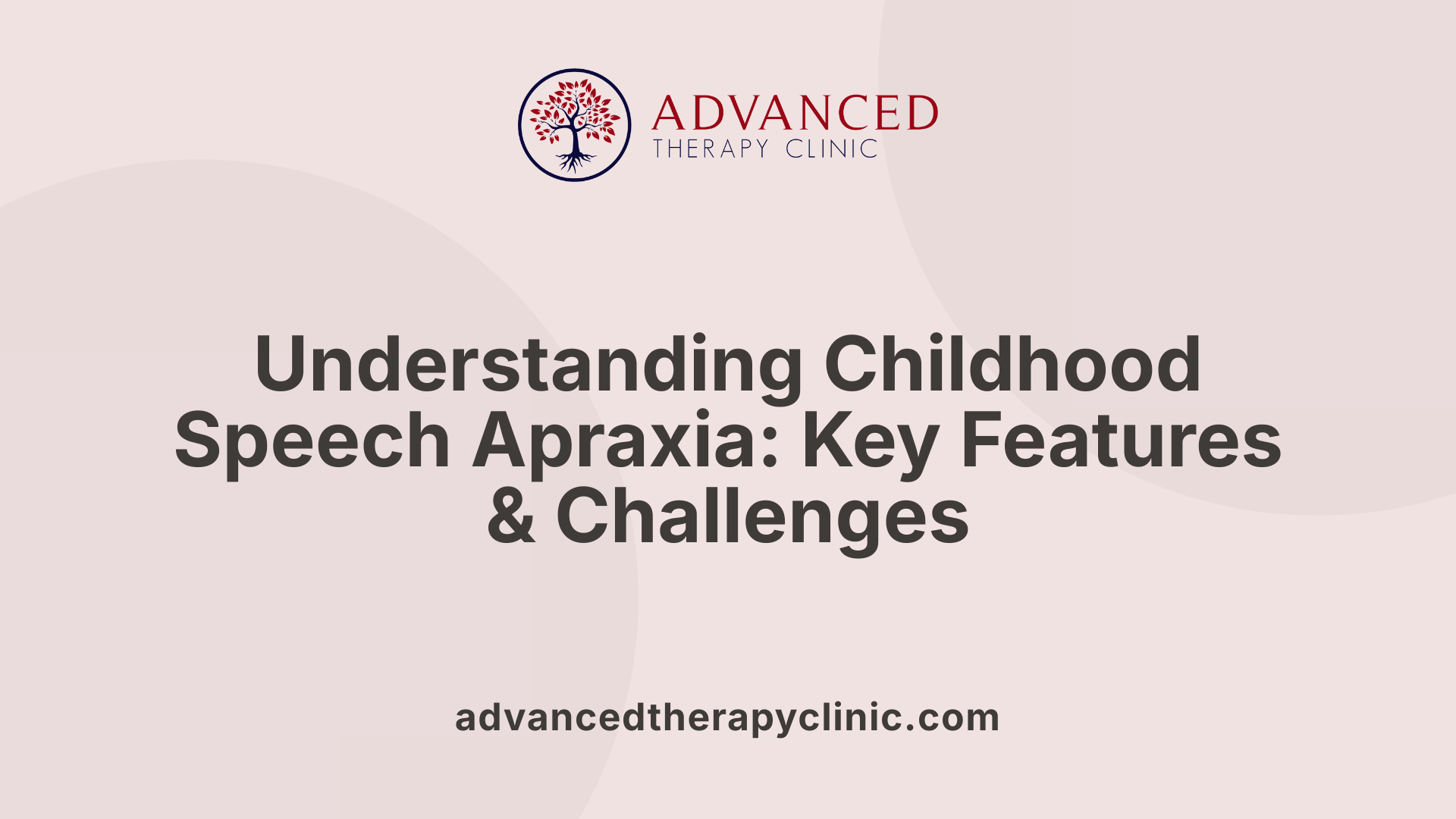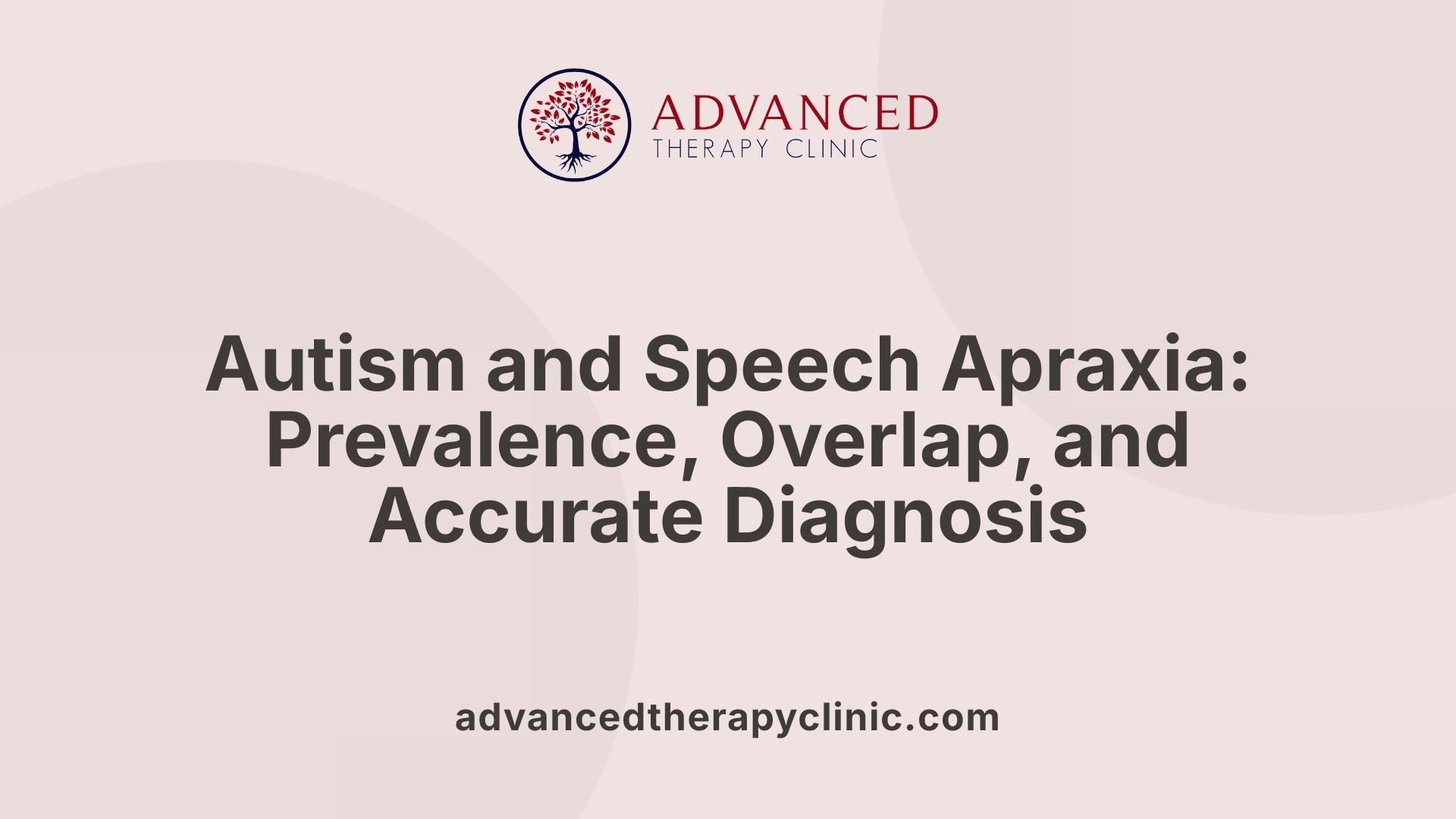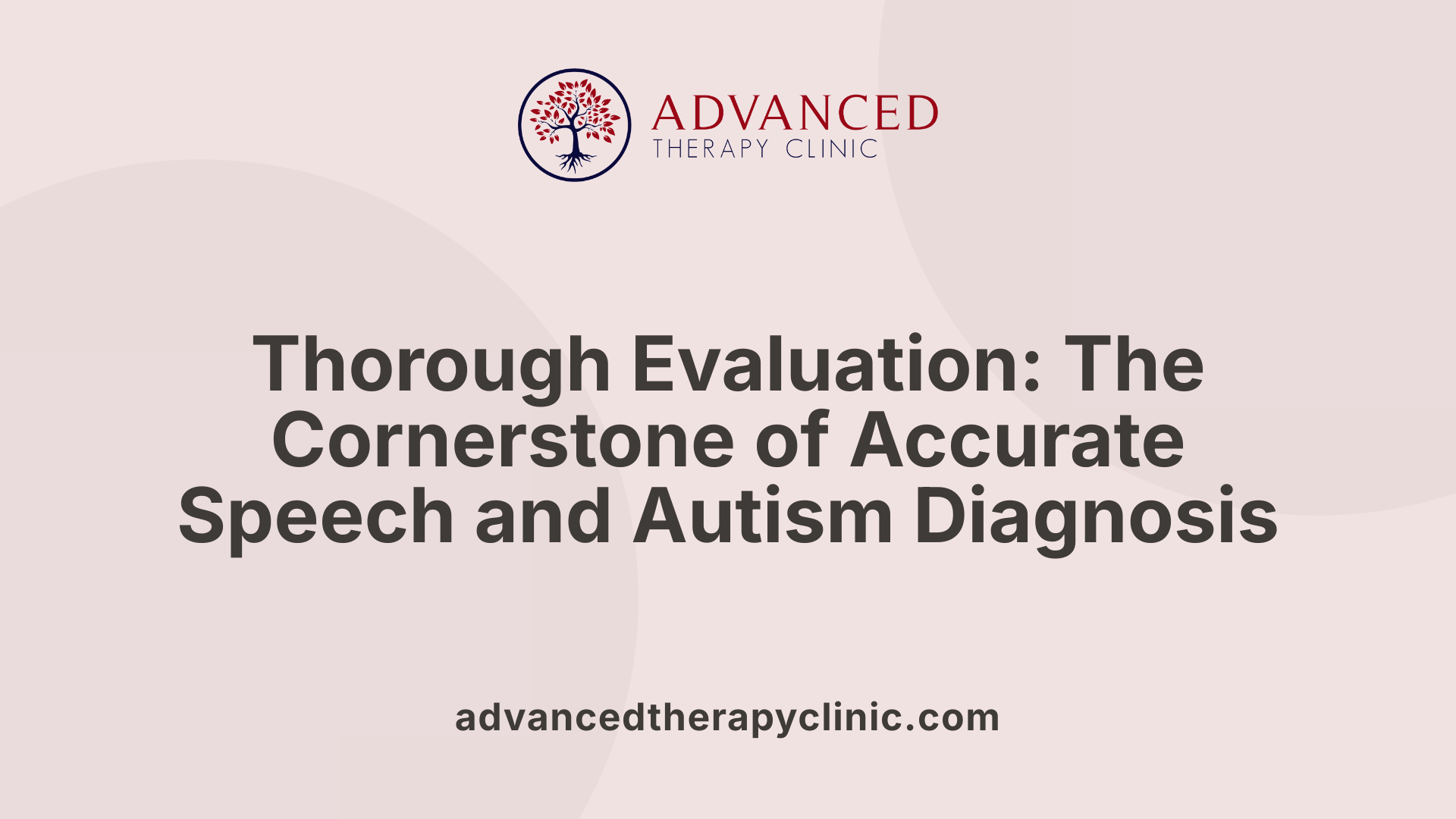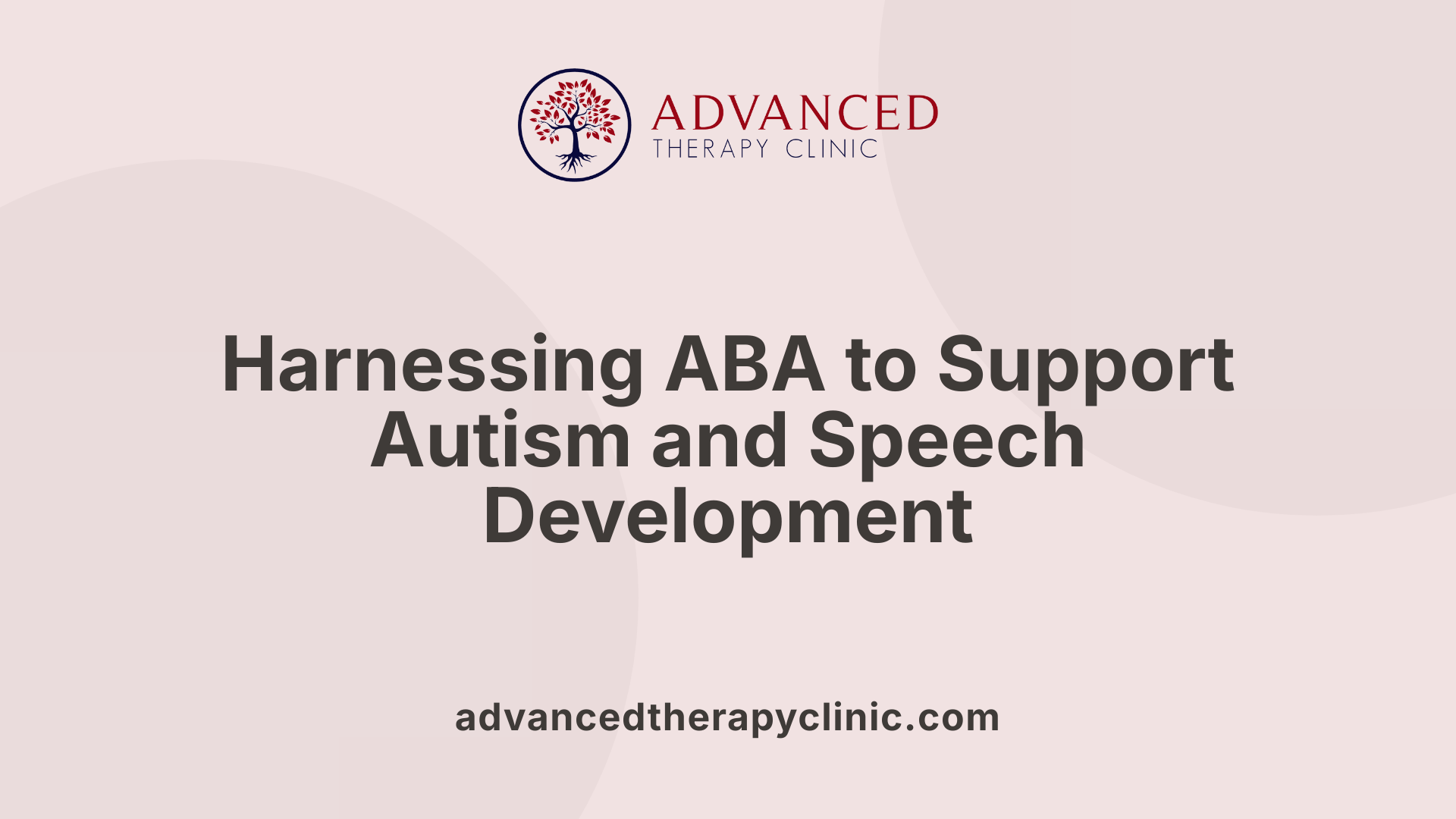Speech Apraxia and Autism


Introduction to Speech Apraxia and Autism
Speech apraxia and autism spectrum disorder (ASD) are distinct yet often overlapping conditions that affect communication and development in children. Understanding their unique characteristics, interrelation, and the multidisciplinary approaches to intervention is crucial for effective treatment and improved outcomes. This article explores the nature of speech apraxia, its prevalence within the autism community, and the therapy-driven interdisciplinary strategies that support children facing these challenges.
Defining Speech Apraxia: Characteristics and Challenges

Motor speech disorder features
Childhood apraxia of speech (CAS) is a motor speech disorder that specifically impairs the coordination of movements necessary for speech. Unlike disorders caused by muscle weakness, children with CAS have normal muscle strength but struggle with planning and sequencing the precise movements of the mouth, lips, jaw, and tongue. This neurological difficulty disrupts how the brain sends signals to the muscles responsible for speech production.
Symptoms in early and later childhood
Symptoms often appear early, such as delayed babbling, limited sound production, and late first words. Young children with CAS may have trouble eating and show inconsistent speech errors. As they grow older, challenges persist with speech clarity, including choppy speech, frequent mispronunciations, and difficulty learning language-based tasks. These patterns make communication unpredictable.
Neurological basis of speech apraxia
CAS results from the brain's impaired ability to send correct motor commands to speech muscles. This disconnect causes inconsistent errors rather than typical articulation mistakes, reflecting underlying neurological dysfunction rather than muscle impairment.
Diagnostic challenges
Because some features of CAS overlap with conditions like autism spectrum disorder, especially in social communication difficulties, misdiagnosis is common. Careful evaluation by speech-language pathologists is critical to distinguish CAS accurately, ensuring appropriate intervention strategies are used.
Understanding these characteristics is important for early identification and tailored treatment to improve speech outcomes in affected children.
Autism Spectrum Disorder and Speech Apraxia: Prevalence and Overlap

Correlation Between Autism and Apraxia
Recent research reveals a significant association between autism spectrum disorder (ASD) and childhood apraxia of speech (CAS), a motor speech disorder. Approximately 63.6% of children diagnosed with autism also exhibit symptoms of speech apraxia, suggesting considerable overlap in these conditions.
Percentage of Children With Autism Affected by Apraxia
This high percentage indicates that nearly two-thirds of children on the autism spectrum may experience difficulty coordinating the movements required for speech, impacting their communication abilities beyond typical ASD challenges.
Differences and Similarities Between Conditions
While ASD and speech apraxia share overlapping features like communication difficulties and inconsistent speech errors, they are distinct disorders. CAS is specifically a neurological speech motor planning deficit, affecting muscle coordination for speech despite intact muscle strength, whereas ASD involves a broader range of social, behavioral, and communication impairments.
Risks of Misdiagnosis
Due to these overlapping symptoms, misdiagnosis can occur. Speech-language pathologists play a crucial role in conducting thorough assessments to differentiate between and identify co-occurring ASD and CAS. Accurate diagnosis is vital to tailor effective treatment plans that address each child’s unique needs, ensuring better outcomes in speech therapy and overall development.
How Common Is Speech Apraxia Among Children With Autism?
Given the significant overlap, speech-language pathologists emphasize careful evaluation of children with autism to detect concurrent apraxia. This comprehensive approach helps prevent misdiagnosis and optimizes early intervention strategies geared toward improving both speech intelligibility and communication skills in affected children.
Diagnostic Approaches and the Importance of Thorough Evaluation

Role of Speech-Language Pathologists
Speech-language pathologists (SLPs) play a critical role in diagnosing and treating childhood apraxia of speech (CAS) and autism spectrum disorder (ASD) related communication difficulties. They use specialized assessment tools to observe speech patterns, motor speech coordination, and language comprehension to understand the underlying causes of communication challenges.
Differentiating Apraxia from Autism-Related Speech Issues
Distinguishing between CAS and speech difficulties linked to autism can be challenging because of overlapping symptoms such as inconsistent speech errors and social communication problems. While CAS primarily involves difficulty coordinating muscle movements needed for speech, autism-related speech issues often include broader social communication deficits. SLPs carefully evaluate motor planning, speech sound production, and social use of communication to identify the correct diagnosis.
Importance of Comprehensive Assessments
Thorough and comprehensive assessments are essential in capturing the nuances between CAS and ASD. These evaluations include systematic observation, standardized testing, and functional analysis of communication abilities across settings. Detailed assessment ensures that interventions match the child's unique needs, promoting more successful outcomes.
Avoiding Misdiagnosis
Misdiagnosis can lead to inappropriate treatment plans that do not address the child's specific challenges. Due to the similarity in some behavioral and speech characteristics, only a rigorous clinical evaluation by experienced SLPs can prevent misdiagnosis and enable targeted, effective therapy strategies.
How are apraxia and autism distinguished in clinical assessment?
Accurate differentiation between speech apraxia and autism-related communication challenges requires comprehensive evaluation by speech-language pathologists, incorporating detailed observation of speech patterns, motor speech skills, language comprehension, and social communication. Careful assessment helps avoid misdiagnosis due to overlapping features and ensures appropriate, targeted intervention.
Applied Behavior Analysis (ABA) in Autism and Speech Challenges

What is applied behavior analysis and how does it support children with autism and speech difficulties?
Applied Behavior Analysis (ABA) is a natural-science approach centered on analyzing the functional relationships between behavior and environmental factors. By using systematic observation combined with intervention techniques, ABA aims to enhance socially significant skills. It leverages methods like functional assessment, discrete-trial teaching, prompting, fading, shaping, and reinforcement to target improvements in language, communication, attention, and social interactions in children with autism.
ABA techniques supporting speech and communication
ABA employs specific strategies that directly support speech and communication development. These include shaping desired verbal behaviors, reinforcing attempts at communication, and teaching the functional use of language such as making requests and expressing ideas. By focusing on behavior-environment relations, ABA helps children improve pragmatic language and social communication skills, thereby complementing speech therapy efforts.
Data-driven methodology
A hallmark of ABA is its structured, data-driven methodology which involves continuous data collection and analysis of behavioral responses. This approach allows therapists to track progress objectively, make informed decisions, and adjust interventions in real-time. The emphasis on measurement and environmental modifications ensures that interventions remain effective and personalized to the child's evolving needs.
ABA’s role in interdisciplinary therapy settings
ABA serves as a foundational component within interdisciplinary treatment programs involving speech and occupational therapy. Its techniques reinforce self-care skills, support peer interactions, and promote generalization of skills across diverse settings such as home, school, and community environments. Collaboration among specialists using ABA principles fosters shared goals and coordinated progress, maximizing positive outcomes for children with autism and speech challenges.
Speech Therapy Techniques for Children with Apraxia and Autism
What are effective speech therapy approaches for children with speech apraxia?
Speech therapy for childhood apraxia of speech (CAS) integrates several specialized techniques to address the unique motor planning difficulties that children experience. Motor programming aims to establish and strengthen the neural pathways responsible for coordinating the mouth, lips, tongue, and jaw movements needed for speech.
Muscle shaping involves directing specific movements and positioning of the speech muscles to produce clearer, more consistent sounds. Therapists use guided practice to help children form correct articulations.
Linguistic strategies focus on enhancing the child’s understanding and use of language. This may involve breaking down language into manageable components, focusing on the function of words in communication, and using structured activities that build expressive and receptive language skills.
Sensory cueing methods provide tactile, visual, or auditory prompts to facilitate accurate speech production. For example, a therapist might tap the child’s jaw to prompt a movement or use visual signals to indicate when to initiate a sound.
Rhythmic techniques use patterns and timing to improve fluency and pacing in speech. Rhythm can help children anticipate and coordinate the sequence of movements required for speech, reducing effort and enhancing intelligibility.
Goals of speech therapy for verbal and nonverbal skills
The overarching aim of speech therapy in children with apraxia, including those also diagnosed with autism, is to improve both verbal and nonverbal communication capabilities. Therapy targets:
- Clearer spoken language, including the production of precise sounds and words.
- Development of nonverbal communication, such as gestures, signs, or the use of communication aids.
- Enhancement of expressive and receptive language to support more effective interaction in social and learning environments.
Through combining these approaches, speech therapy not only enhances speech intelligibility but also fosters overall communication skills, which are crucial for social engagement and learning. Early and individualized intervention, often involving family participation, significantly benefits children’s progress.
Early Intervention: Critical for Positive Outcomes
Why is early intervention important for children with autism and speech apraxia?
Early intervention, ideally initiated before school age, plays a vital role in supporting children with autism and speech apraxia. Starting therapy early can lead to significant improvements in a range of skills, especially communication, social interactions, and cognitive abilities. Both autism and childhood apraxia of speech (CAS) involve challenges in speech and communication, and addressing these conditions early helps reduce delays and promotes more effective learning.
Benefits of starting therapy before school age
Beginning therapy prior to school entry accelerates developmental gains during a window when the brain is most adaptable. Early treatment helps children develop essential skills such as language comprehension, verbal expression, and social communication, which set the foundation for academic and personal success. It also contributes to improvements in motor and cognitive skills, which are often affected in these populations.
Family involvement and support
Active family participation enhances the effectiveness of early intervention. Families who are involved in therapy are better equipped to reinforce learning and communication practices in daily routines. This consistent encouragement strengthens developmental progress, improves generalization of skills across settings, and fosters a supportive environment crucial for the child’s growth.
Use of online and technology-enhanced therapy
Technology like interactive apps and online therapy platforms can complement traditional intervention techniques. These tools provide flexible, engaging options that can increase therapy accessibility and maintain children's motivation. Virtual reality and digital communication aids also support social skills development and enable therapists and families to collaborate more efficiently.
Overall, combining early intervention with family support and technology-enhanced resources maximizes outcomes for children with autism and speech apraxia, promoting more positive developmental trajectories.
Occupational and Physical Therapy Contributions
How do occupational and physical therapies support children with autism and speech apraxia?
Occupational therapy plays a crucial role in supporting children with autism and speech apraxia by focusing on daily living skills and sensory processing. Therapists work to improve fine and gross motor skills, sensory regulation, and communication abilities, as well as play skills that enhance participation in everyday routines. This therapy aims to increase children's independence and functionality by adapting activities and developing skills essential for daily life.
Physical therapy complements these efforts by targeting gross motor development, balance, strength, and coordination. It assists children in reaching important developmental milestones such as sitting, crawling, and walking, which are foundational for overall mobility and physical health.
Both therapies strongly emphasize working within natural environments to ensure children can apply learned skills in meaningful contexts.
Interdisciplinary collaboration is vital; occupational and physical therapists coordinate closely with Applied Behavior Analysis (ABA) and speech-language therapy teams. This joint approach ensures consistent goals across therapies, maximizes progress, and enables real-time adjustments based on the child's evolving needs. For example, ABA's reinforcement strategies support occupational therapy goals like self-care skills, while speech therapy addresses communication challenges enhanced by improved motor control.
Together, these therapies provide a holistic and comprehensive support system, empowering children with autism and speech apraxia to improve communication, motor function, and daily living abilities necessary for their independence and social participation.
Nutritional Therapy as a Complementary Approach
What role does nutritional therapy play in autism care?
Nutritional therapy plays a critical role in the holistic treatment of children with autism by focusing on dietary assessments and tailored interventions. Many children with autism experience food sensitivities and gut health challenges, which can impact their overall wellbeing. Addressing these nutritional concerns is essential for improving digestive health and reducing discomfort.
Addressing food sensitivities and gut health
Therapists conducting nutritional interventions look for food intolerances, allergies, and digestive issues that might exacerbate behavioral or sensory symptoms. Managing these factors often leads to improved gut function and may reduce related behaviors such as irritability or inattention.
Impact on overall functioning
Improved nutrition can positively influence energy levels, cognition, mood, and physical health. These changes make it easier for children to participate actively in therapy and daily activities, thereby enhancing their developmental progress.
Integration with behavioral and speech therapies
When combined with Applied Behavior Analysis (ABA), speech therapy, and occupational therapy, nutritional therapy supports a comprehensive care model. By stabilizing physical health, nutritional therapy enables better engagement with communication and behavior-focused interventions. This integrated approach fosters greater gains in social, cognitive, and adaptive skills for children with autism.
Interdisciplinary Collaboration for Comprehensive Treatment
Why is interdisciplinary collaboration important in treating children with autism and speech apraxia?
Effective treatment of children with autism and speech apraxia depends heavily on strong interdisciplinary collaboration. This is because these complex conditions affect multiple domains such as communication, behavior, motor skills, and sensory processing, which require expertise from various therapy disciplines.
Behavior analysts, speech-language pathologists, occupational therapists, physical therapists, and other professionals each bring unique knowledge and treatment strategies. When these professionals work as a coordinated team, they foster a better understanding of one another’s roles, methods, and knowledge boundaries. This mutual respect and open communication enable them to craft more cohesive, client-centered treatment plans.
Importance of teamwork among therapy disciplines
Teamwork ensures that therapy goals align across disciplines, reducing duplication and conflicting strategies. For example, Applied Behavior Analysis (ABA) techniques designed to improve communication and social skills complement speech therapy approaches that target speech production and pragmatic language. Similarly, ABA reinforces self-care skills that bolster occupational therapy's focus on daily living activities.
Communication and respect among professionals
Clear, ongoing communication supports sharing of assessment data and progress reports. This transparency allows for real-time adjustments in intervention strategies based on each discipline’s observations and findings. Respect for each profession's distinct contributions encourages collaborative problem-solving and holistic care.
Benefits of shared goals and unified progress tracking
Sharing goals and progress data facilitates consistent tracking of a child’s development across behavior, speech, motor skills, and social interactions. This unified approach promotes the generalization of skills across settings such as home and school, benefiting overall child functioning.
Personalized, data-driven treatment adjustments
The use of data-driven methods, a hallmark of ABA, integrates well with other therapies by providing quantitative measures of effectiveness. This allows teams to personalize interventions dynamically, ensuring that changes are based on evidence and tailored to each child’s evolving needs.
Overall, interdisciplinary collaboration maximizes therapy efficacy, enriches family involvement, and supports early intervention—critical to improving communication and daily functioning outcomes in children with autism and speech apraxia.
Technology in Therapy: Enhancing Engagement and Progress
How does technology support children with autism and speech apraxia in therapy?
Technology plays a pivotal role in modern therapeutic approaches for children with autism and speech apraxia. Interactive apps provide engaging platforms where children can practice communication and language skills in a fun, motivating way. These apps often use games and rewards to encourage participation and reinforce learning.
Virtual reality (VR) further enriches therapy by creating immersive environments where children can safely practice social interactions and daily living skills. VR simulations offer controlled, repeatable scenarios that help children develop confidence in real-world settings.
Supporting social skills and communication
Technological tools support social skill development by simulating peer interactions and teaching appropriate social behaviors through interactive and feedback-rich experiences. For children with speech apraxia, technology complements therapeutic techniques that improve muscle coordination and speech clarity by incorporating sensory cueing and motor programming exercises into engaging formats.
Augmenting traditional therapy methods
Technology does not replace traditional therapies but enhances them by providing additional modes of practice. Therapists can integrate these digital tools with applied behavior analysis, speech-language therapy, and occupational therapy to create personalized, data-driven treatment plans. Real-time tracking and feedback enabled by technology help professionals tailor interventions more effectively, maximizing overall progress.
In summary, the incorporation of technology like interactive apps and VR is transforming therapy for children with autism and speech apraxia, making treatments more engaging, effective, and adaptable to individual needs.
Behavioral Techniques to Support Social and Self-Care Skills
How does ABA support social and self-care skills development in children with autism?
Applied Behavior Analysis (ABA) plays a crucial role in helping children with autism develop essential social and self-care skills. By reinforcing appropriate social behaviors, ABA encourages improvements in peer interactions and helps children adapt to group settings more comfortably.
ABA reinforcement of social behaviors
ABA techniques focus on identifying and reinforcing positive social interactions. Through systematic observations and tailored interventions, children learn behaviors such as making eye contact, sharing, taking turns, and developing conversational skills. These reinforced social skills are vital for building relationships and navigating social environments effectively.
Teaching self-care through positive reinforcement
Self-care activities like dressing, eating, and maintaining hygiene are taught using positive reinforcement strategies. ABA professionals use prompting and shaping methods to guide children step-by-step through these routines, rewarding successful attempts and gradually reducing assistance. This approach enhances the child’s independence and confidence in daily living tasks.
Generalizing skills across settings
One of ABA’s strengths is its structured, data-driven methodology that supports the generalization of skills beyond therapy sessions. Children are encouraged to apply social and self-care skills in various settings such as home, school, and community environments. This transfer of learning ensures that gains in therapy translate into real-world independence and improved quality of life.
Evidence-Based Programs: Integrating ABA and Developmental Approaches
What is the Early Start Denver Model and its significance?
The Early Start Denver Model (ESDM) stands out as a pioneering evidence-based intervention for young children with autism spectrum disorder (ASD). It integrates Applied Behavior Analysis (ABA) with developmental strategies, creating a comprehensive framework that targets multiple areas of early childhood development.
ESDM uses naturalistic and play-based techniques to engage children, promoting growth in cognitive, linguistic, social, and motor domains. Unlike traditional ABA, which often relies on structured trials, the model emphasizes learning through everyday interactions and child-initiated activities, helping children generalize skills across settings.
Studies support ESDM’s effectiveness, indicating that children receiving this intervention show significant improvements in IQ, language, and adaptive behavior compared to those receiving standard care. The early, intensive nature of ESDM is critical, aligning with the consensus that intervention before school age leads to better outcomes.
By blending rigorous ABA methodologies with developmental insights, ESDM offers a balanced approach that addresses the complex needs of young children with ASD, making it a vital tool in early intervention programs.
Conclusion: Toward Integrated Care for Speech Apraxia and Autism
Speech apraxia and autism spectrum disorder present complex, interwoven challenges that require nuanced understanding and specialized intervention. Recognizing the prevalence of apraxia within the autism community and differentiating between these conditions through expert assessment is essential. The integration of therapies—including Applied Behavior Analysis, speech-language pathology, occupational and physical therapy, nutritional support, and technology—within an interdisciplinary framework maximizes personalized care. Early, collaborative intervention, grounded in evidence-based practices, offers the greatest potential for meaningful progress in communication, social skills, and daily functioning, ultimately enhancing quality of life for children and families.
References
Recent articles

Expressive Speech Delay 2-Year-Old
Understanding and Addressing Expressive Speech Delay in Toddlers

How Speech Recognition Works
Unlocking the Power of Speech Recognition in Therapy and Healthcare

Autism and Head Size
Understanding the Complex Relationship Between Autism and Head Size

Occupational Therapy in Autism
Enhancing Independence and Quality of Life Through Occupational Therapy in Autism

Do Autistic People Understand Sarcasm?
Navigating the Nuances: Understanding Sarcasm and Social Communication in Autism

Autism Routines
Crafting Effective Daily Structures for Children with Autism

